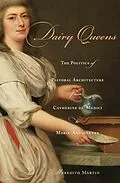In a lively narrative that spans more than two centuries, Meredith Martin tells the story of a royal and aristocratic building type that has been largely forgotten today: the pleasure dairy of early modern France. These garden structures-most famously the faux-rustic, white marble dairy built for Marie-Antoinette's Hameau at Versailles-have long been dismissed as the trifling follies of a reckless elite. Martin challenges such assumptions and reveals the pivotal role that pleasure dairies played in cultural and political life, especially with respect to polarizing debates about nobility, femininity, and domesticity. Together with other forms of pastoral architecture such as model farms and hermitages, pleasure dairies were crucial arenas for elite women to exercise and experiment with identity and power.Opening with Catherine de' Medici's lavish dairy at Fontainebleau (c. 1560), Martin's book explores how French queens and noblewomen used pleasure dairies to naturalize their status, display their cultivated tastes, and proclaim their virtue as nurturing mothers and capable estate managers. Pleasure dairies also provided women with a site to promote good health, by spending time in salubrious gardens and consuming fresh milk. Illustrated with a dazzling array of images and photographs, Dairy Queens sheds new light on architecture, self, and society in the ancien regime.
Zusammenfassung
Though Meredith Martin is primarily an art historian, this book goes way beyond art history. It examines "e;pleasure dairies,"e; built by the French aristocracy to be sites of leisure, healing, and simple luxury, from the vantage point of cultural studies as well as social and political history. The traditional historical narrative, still deeply resonant, is that these dairies were little more than frivolous excess or attempts to imagine "e;common life"e; by people so wealthy they could not even imagine poverty. But Martin complicates this picture. She examines the social, cultural, and political uses of these dairies, showing that they were in fact instrumental as sites that both reinforced and challenged definitions of femininity. The dairies provided strategic venues for noble women to assert their status and identity while at the same time appearing to retreat from power. They served the functions of a spa, where fresh milk and beautiful scenery helped women recover their health. They also are tangible evidence of the new valorization of country living, which was expressed also in political debates about improving the countryside and reforming the aristocracy, especially elite women.
Zusammenfassung
Though Meredith Martin is primarily an art historian, this book goes way beyond art history. It examines "e;pleasure dairies,"e; built by the French aristocracy to be sites of leisure, healing, and simple luxury, from the vantage point of cultural studies as well as social and political history. The traditional historical narrative, still deeply resonant, is that these dairies were little more than frivolous excess or attempts to imagine "e;common life"e; by people so wealthy they could not even imagine poverty. But Martin complicates this picture. She examines the social, cultural, and political uses of these dairies, showing that they were in fact instrumental as sites that both reinforced and challenged definitions of femininity. The dairies provided strategic venues for noble women to assert their status and identity while at the same time appearing to retreat from power. They served the functions of a spa, where fresh milk and beautiful scenery helped women recover their health. They also are tangible evidence of the new valorization of country living, which was expressed also in political debates about improving the countryside and reforming the aristocracy, especially elite women.
Titel
Dairy Queens
Untertitel
The Politics of Pastoral Architecture from Catherine de' Medici to Marie-Antoinette
Autor
EAN
9780674059474
Format
E-Book (pdf)
Hersteller
Genre
Veröffentlichung
15.02.2011
Digitaler Kopierschutz
Adobe-DRM
Unerwartete Verzögerung
Ups, ein Fehler ist aufgetreten. Bitte versuchen Sie es später noch einmal.
